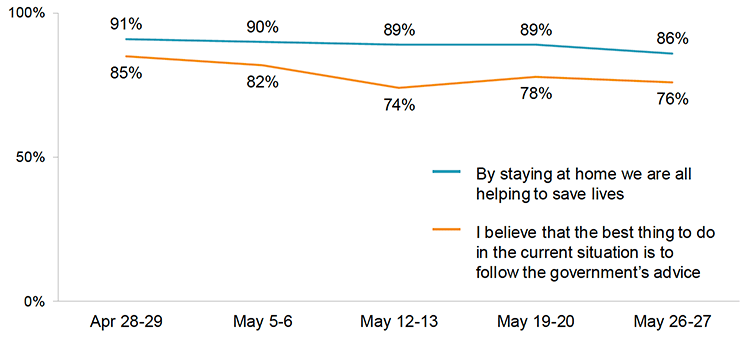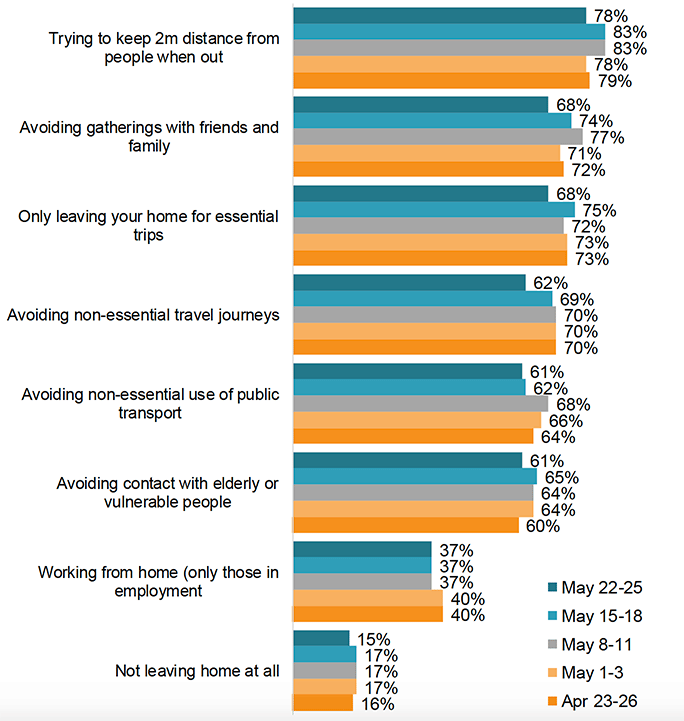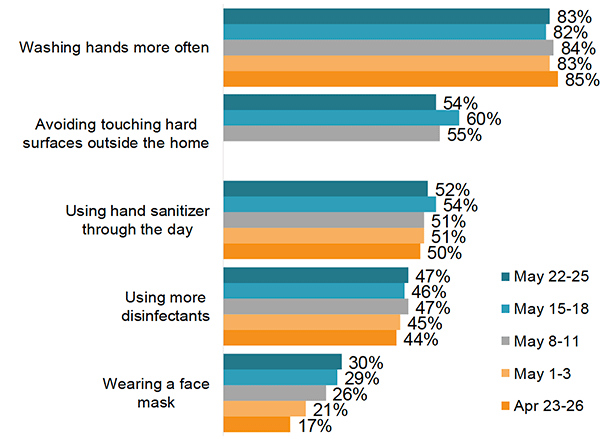Public attitudes to coronavirus: May summary
This report includes some high level findings from recent polling work on public attitudes to the coronavirus pandemic in Scotland. A report covering earlier survey work was published on 8 May 2020.
This document is part of a collection
2. Compliance
Views on guidance
Respondents were asked about their views on government guidance and advice. As shown in Figure 6, the vast majority of respondents agreed that 'by staying at home we are all helping to save lives', and this has remained relatively stable since the end of April. There was also strong agreement with the statement 'I believe the best thing to do in the current situation is to follow the government's advice' although since the end of April there has been a fall in the proportion agreeing with this.

Source: YouGov weekly Scotland survey. Base (n=1004-1037)
Levels of compliance
Respondents were asked which social distancing guidelines they were following from a list provided. As shown in Figure 7, the majority of respondents claimed to be following each of the options shown about avoiding contact, gatherings and non-essential travel or trips. However, the proportions who were trying to keep 2 metres distance when out, avoiding gatherings with friends and family, avoiding non-essential travel and only leaving home for essential trips have fallen in the most recent survey wave.
Of those who were employed, just under two fifths said they were working from home.

Source: Ipsos MORI, Scotland data. Base (n=500-684)
Personal protective actions
Respondents were also asked which personal hygiene actions they had taken to protect themselves from Coronavirus. As shown in Figure 8, the vast majority of respondents reported washing their hands more often, which has remained relatively stable over the last month. Around half were also avoiding touching hard surfaces outside the home, using hand sanitiser throughout the day and using more disinfectants.
While the proportion reporting wearing a face-mask is relatively low, this has increased since the end of April.

Source: Ipsos MORI, Scotland data. Base (n=500-684)
Testing
Respondents were asked at two surveys waves whether they agreed or disagreed with statements about testing, tracing and isolation. As shown in Table 1, the vast majority of respondents agreed with each statement.
Table 1: Proportion who agreed or agreed strongly with each statement about testing
| Statements |
% who agreed/ agreed strongly |
|---|---|
| I would be willing to isolate for 14 days if someone I had come into contact with had Coronavirus symptoms |
90% |
| I would be willing to undergo Coronavirus testing if asked to do this by the NHS |
90% |
| Source: YouGov weekly Scotland survey May 12-13. Base (n=1007) |
|
| As part of Scotland's testing process I would be happy to provide details of people I had been in contact with if I developed coronavirus symptoms |
88% |
| If I had coronavirus symptoms, I would want to have a test if at all possible |
88% |
| I understand the importance of testing to stop the spread of coronavirus |
91% |
| Source: YouGov weekly Scotland survey May 19-20. Base (n=1037) |
|
Contact
Email: covid-19.behaviours@gov.scot
There is a problem
Thanks for your feedback